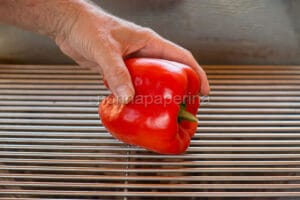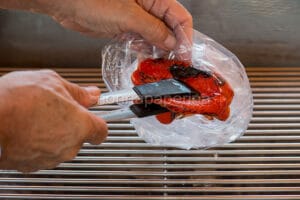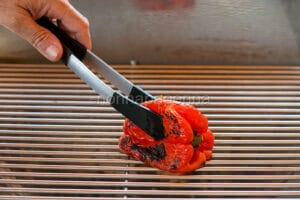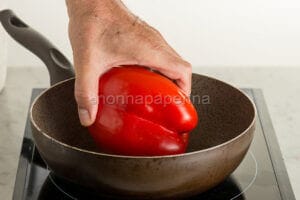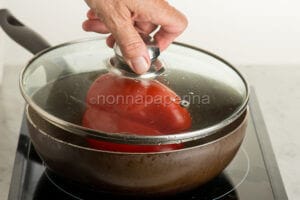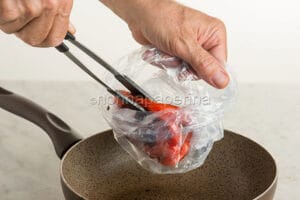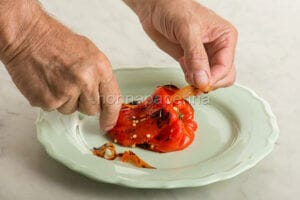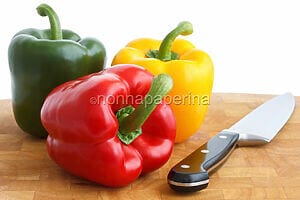How to peel bell peppers, the complete guide
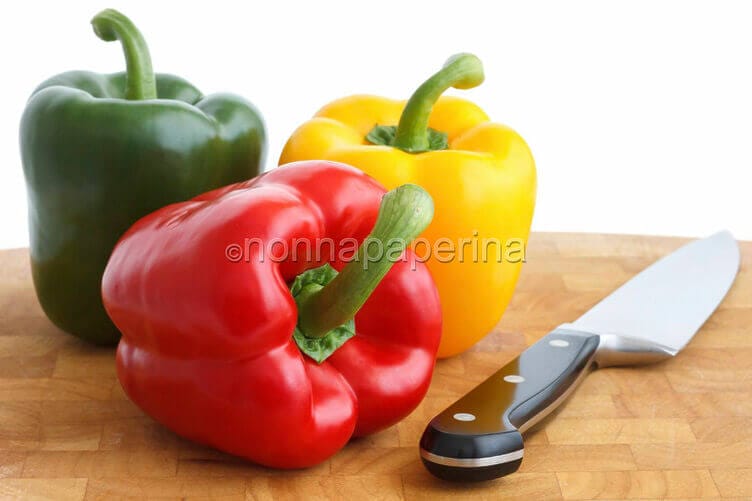
The main characteristics of bell peppers
Bell peppers are among the most popular vegetables, as seen by the large number of recipes that include them, despite the fact that they are not always easy to peel. They are also very flexible and can be prepared and served in a variety of ways. My grandmother has always told me that skinless bell peppers are more palatable. There are several ways to peel bell peppers.
They cook beautifully when baked, grilled, and pan-fried (perhaps with a little oil). There are numerous quick and simple recipes available. Both roasted and creamed bell peppers are my favourites.
They serve as the primary component in side dishes or as a condiment for meat and vegetables. They can be consumed fresh or added to salads, cold pasta dishes, or dips.
Eat bell peppers with or without peel?
Removing the skin from bell peppers is a common practice for several reasons:
- digestibility: It’s well known that some people find it difficult to digest peppers’ outer skin. contains cellulose, a plant fibre that some people may find difficult to digest, which could lead to gastrointestinal discomfort or bloating.
- flavour and texture: The skin of bell peppers can have a slightly taut texture and a bitter or slightly spicy flavour. By peeling the peppers, you remove this part and obtain a more tender and sweet pulp.
- aesthetics: Peeling bell peppers can improve the appearance of culinary preparations, especially if you want a more uniform texture and a more pleasant appearance on the plate.
- culinary preparations: The skin of the bell peppers may not produce the right consistency or flavour in some recipes, such as sauces or soups. For optimal culinary outcomes, it is therefore advisable to remove the skin.
It is crucial to remember that bell pepper skin is edible and full of fibre and minerals. So you can safely eat bell peppers with their skin to obtain more fibre and nutrients, provided you don’t have issues with digestion or don’t mind their consistency.
The decision to peel bell peppers or not depends on your personal preferences and the specific culinary needs of your recipes.
How to peel raw bell peppers
When discussing how to peel bell peppers, the first scepticism is whether or not they can be peeled raw like a fruit or vegetable. Although the smooth texture may worry some people, the method is actually quite simple. You only need to equip yourself with a potato peeler as a tool.
To make handling bell peppers easier, it is advised to chop them lengthwise. All that is left to do at this stage is grab the first slice and lightly pass the potato peeler from top to bottom. As there is always a chance of pulling the pulp away, extreme care must be taken.
Keep in mind that the bell pepper peel is more of a film than a true peel, and as a result, it adheres to the fruit quite strongly. You must use this technique if you want to eat raw bell peppers.
Yes, they are easily digestible after being peeled, even raw. They are ideal for salads and dips because of this. Cut the bell peppers in half, then take out the stem, seeds, and white filaments to clean them.
How to peel baked bell peppers
Peeling roasted bell peppers: what should I do? Bell peppers can be prepared in the oven as well. In this function, they could possibly be used as a side dish with meat or as a sandwich filling. The technique uses baking parchment instead of lipids like oil or butter, so it is minimal in calories as well as other things.
What should I do in this situation? Peeling bell peppers after cooking is advised because the film shields the pulp from excessive heat, facilitating cooking and preventing the vegetable from disintegrating.
The oven needs to be preheated first. This will assist in removing the bell peppers’ skin in addition to ensuring more consistent cooking. Additionally, the temperature must be quite low, around 140 degrees, and at the drying limit.
The bell peppers need to be coated with extra virgin olive oil before going into the oven. When heat and oil come into contact, a certain process results in the “spontaneous” lifting of the film from the pulp.
They need to cook, incidentally, for around 20 minutes. Bell peppers should be turned every 5 minutes. All that is left to do after cooking is start hand-peeling. With a smooth blade, carefully cut the peppers lengthwise into two or four pieces, then peel them. Peeled bell peppers that have been cooked can be used in numerous dishes.
How to peel grilled bell peppers
The grill is undoubtedly the quickest method for cooking peppers, especially if you’re getting ready to have a good barbecue. Peppers can go with meats and other veggies in this manner.
It is a very prevalent custom, especially in some regions of southern Italy, to fill grilled bell peppers with sausage. But how are grilled bell peppers peeled? Utilising a plastic food bag, which is used to freeze food, is the trick.
After cooking, they ought to be put into paper or plastic food bags and let cool for ten minutes. The skin of the bell peppers will separate from the pulp due to the steam produced by the peppers themselves and trapped by the bag. At that time, slicing it in half with a knife will be simple work. The bell peppers should, of course, be packed as soon as possible while they are still quite hot.
How to peel bell peppers in a pan
It’s harder than you may think to peel the bell peppers and fry them in a skillet. There is a good probability they will burn and sink unless you practically immerse them in oil. Given that bell peppers require a lengthy amount of pan cooking time, there is a substantial risk involved. In order to prevent flaking and burning, it is best to reduce the flame to minimal because it usually takes thirty to forty minutes.
Fortunately, peeling them is extremely easy once they are well cooked. However, the heat itself has the tendency to separate the skin from the pulp. The pulp inside gradually dries up as a result.
Alternatively, you can use the bag method: as soon as they are cooked, place the peppers in a food bag, close it, and wait for the steam to do its job. Then it will only take a few seconds to remove the skin from the peppers.
How to microwave bell peppers to remove their skin
Peeling the bell peppers is simple, even in the microwave. It’s important to cook the peppers completely, just like with the other techniques. You must do this by setting a 15-minute timer and the highest power.
The bell pepper placement must be done with extreme care. Slices must first be made of them. Then, placing them on the plate in a circle while largely avoiding the centre is required.
This prevents the extended emission of electromagnetic radiation by allowing the vegetable’s entire body to spin.
These two tiny amounts are sufficient to provide the same outcomes as other cooking techniques; in fact, doing it this way will result in the “automatic” removal of the film from the pulp. The capacity of the microwave, which is often much smaller than that of the oven or pan, is the only drawback to this method.
The bell pepper’s nutritional value
The nutritional benefits of bell peppers are intriguing and frequently underappreciated. It’s interesting to consider the advantages that these veggies contribute to our diet in addition to the practice of peeling them:
They are a crucial part of our diet because they are a great source of vitamins. They are rich in vitamin A, which is necessary for maintaining eye health. Additionally, they contain a lot of vitamin C, which has antioxidant characteristics and helps boost the immune system.
They offer crucial mineral salts. They are rich in potassium, which is necessary for controlling blood pressure. They also contain iron, calcium, and phosphorus, which are minerals that are frequently found in animal products or legumes. It’s noteworthy that bell peppers have a high iron content because they give vegetarians and vegans another way to receive their iron.
They are also a good source of fibre, which can aid in making the preparations they are used in more digestible. Fibre can support regular intestinal transit and is crucial for digestive health.
The particular colour of each bell pepper variety distinguishes it from the others. The presence of particular dietary components affects its colour. For instance, red bell peppers are a good source of the potent antioxidants lycopene and lutein. On the other hand, yellow bell pepper contains a good source of beta-carotene, a vitamin A precursor. These kinds provide a wide variety of advantageous nutrients.
The low calorie count of bell peppers is another benefit. They are a light and healthy option for anyone striving to maintain their weight or adhere to a low-calorie diet because they only have about 30 calories per 100 grammes.
In conclusion, bell peppers are a wholesome, delectable, and adaptable meal that can be used in a variety of cuisines. They are a smart choice for people trying to maintain a balanced and nutritious diet because of their nutritional qualities.
Some varieties of bell peppers
There are many distinct types of bell peppers, and each one has unique attributes such as colour, flavour, and culinary usage. Some of the most popular pepper types are listed below:
- Green: This kind, which is the most popular, is harvested before it has fully ripened, giving it its green hue. Compared to ripe bell peppers, they are often crunchier and a little less sweet.
- Red: Red bell peppers are ripe green bell peppers. They are sweet, succulent, and more tender than green bell peppers. They are widely used in salads, sauces, and roasted preparations.
- Yellow: Yellow bell peppers are ripe but less sweet than red bell peppers. They have a slightly brighter flavour and are good for cooking and grilling.
- Orange: These bell peppers are sweet and flavorful, with a bright orange color. They are often used to add a pop of colour and flavour to dishes.
- Purple: This variety has a dark purple colour and a sweet, rich lavor. They are less common than the red, green, yellow, and orange varieties but can be used for a pop of funky colour.
- Sweet: This category includes many varieties of bell peppers with a sweet, non-spicy flavor. They are ideal for using raw in salads or as a snack.
- Hot: Hot pepper varieties include jalapeños, habaneros, serranos, and many others. They are widely used to add heat to dishes, such as Mexican foods or hot sauces.
- Banana: These peppers are generally long and narrow, with a banana-like shape. They are sweet and crunchy and are often used in salads or as snacks.
- Cubanelle: This variety is sweet and tasty, with a slightly curved shape. It is often used in Italian and Caribbean cuisine to prepare dishes such as peperonata or pepper fillings.
- Poblano: These medium-sized peppers have a little smokey flavour. Both the popular home-style dish “chiles en nogada” and the mole sauce contain them as a vital component.
In addition to these types, there are a large number of different pepper varieties available worldwide, each with specific qualities that set it apart. Your own preferences and the type of food you intend to make will frequently influence the variety you choose.
Excellent to include in a low-nickel diet
Bell peppers are a good choice for those who are sensitive to nickel because they are typically thought to have little nickel. Some foods contain the metal nickel, which can make some sensitive people allergic or intolerance-prone.
However, it is crucial to remember that the amount of nickel in different foods can vary depending on a number of variables, including the type of food, the growing technique, and the region in which it is produced. Nuts, seeds, chocolate, and other leafy green vegetables are examples of foods that are not anticipated to have elevated levels of nickel.
Bell peppers are generally thought to be safe for individuals who are nickel-intolerant, but it is always best to speak with a medical practitioner or dietitian to customise your diet based on your unique needs and food sensitivities. In order to prevent negative responses, people with nickel sensitivity should also be cautious about the other foods they eat in addition to bell peppers.
Rotation diet to reduce nickel content
A rotating diet may be a helpful choice for those with nickel sensitivity or other food allergies to lessen nickel exposure and prevent negative reactions. The rotation diet involves mixing up the foods eaten to prevent consuming too much food with a high nickel level.
Here is how it works:
- Food List: Start with a list of foods that contain nickel and those that are low in nickel. This list can be consulted as you plan your meals.
- Rotate sources: When planning your meals, try to vary your food sources. For example, instead of consuming the same type of fish or meat every day, try alternating protein sources. The same goes for fruits, vegetables, grains, and dairy products, if you consume them.
- Monitoring reactions: During the rotation diet, it is important to keep a food diary to record the foods consumed and any adverse reactions. This can help you identify any food triggers and further adapt your diet.
- Beware of foods with high nickel content: Some foods, such as nuts, chocolate, tomatoes, and some types of fish, are not meant to have a high nickel content. Try to limit your consumption of these foods and only include them occasionally in your diet.
- Always consult a dietitian: A low-nickel diet and a rotation diet can be complex to plan and manage. It is advisable to consult a dietician or allergist specialising in food allergies to create a personalised meal plan and receive specific guidance on the rotation diet.
A rotating diet can help you eat a more varied diet and expose you to less nickel, lowering your risk of developing allergies or intolerances. To guarantee efficient management of food intolerances, it is crucial to customise your diet to your specific needs and adhere to the advice of your healthcare provider.
All rights reserved
COULD IT BE INTERESTING FOR YOU

A bartender’s equipment for making excellent cocktails
Why invest in bartending supplies? In this guide, we'll talk about a bartender's equipment, that is, all those tools, accessories, and products that help prepare cocktails, mocktails, and, in...







